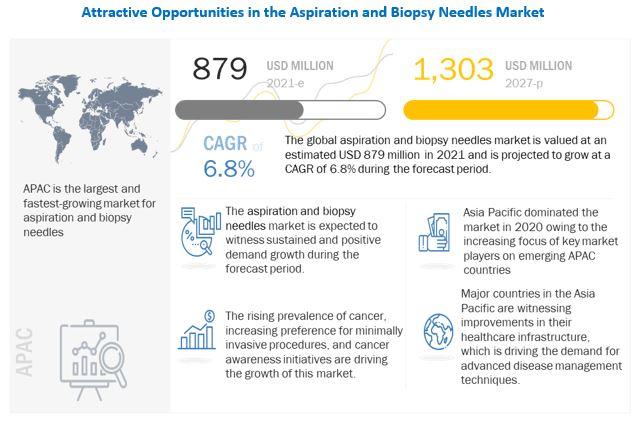[203 Pages Report] The global aspiration needles market is valued at an estimated USD 879 million in 2021 and is projected to reach USD 1,303 million by 2027, at a CAGR of 6.8%. Factors such as the rising prevalence of cancer, initiatives undertaken by government and global health organizations, and the increasing preference for minimally invasive procedures are the major factors driving the growth of the aspiration and biopsy needle market.
According to estimates from the International Agency for Research on Cancer (IARC), in 2018, there were 17.0 million new cancer cases and 9.5 million cancer deaths worldwide. By 2040, the global burden is expected to grow to 27.5 million new cancer cases and 16.3 million cancer deaths, primarily due to the growth and aging of the population.
Globally, there has been a significant increase in the number of people suffering from cancer. This can be attributed to a number of factors, such as lifestyle changes, unhealthy diets, and increasing tobacco consumption.
The incidence of cancer is the highest in more-developed regions, but mortality is relatively higher in less-developed countries due to a lack of access to treatment facilities and a lack of awareness regarding the benefits of early detection.
Download PDF Brochure @ https://www.marketsandmarkets.com/pdfdownloadNew.asp?id=71036825

With the growing awareness about different types of cancers, the demand for biopsy procedures is expected to increase in the coming years. However, there is a dearth of skilled surgeons to perform minimally invasive biopsy procedures. For instance, a shortage of more than 2,300 medical oncologists is expected in the US by 2025 (Source: Journal of Global Oncology).
The effect of this factor will be more pronounced in developing and underdeveloped regions. For instance, one of the major obstacles in the delivery of care for patients with curable cancers in the Sub-Saharan African region is the dearth of medical oncologists, radiation oncologists, and other healthcare workers required for cancer care.
Similarly, India is facing an acute shortage of oncologists, radiotherapists, and surgical oncologists. With 1.8 million cancer patients in the country, there is only one oncologist to treat every 2,000 patients.
